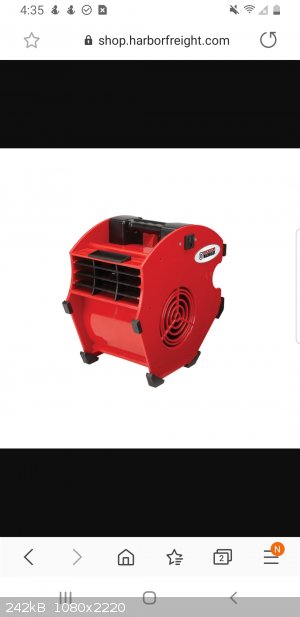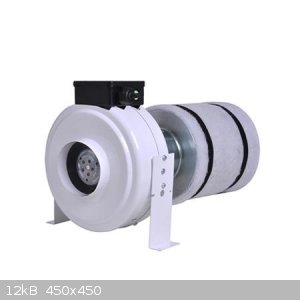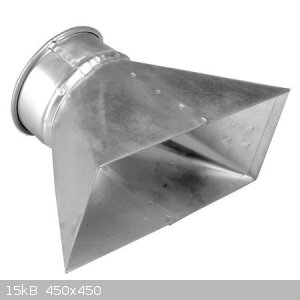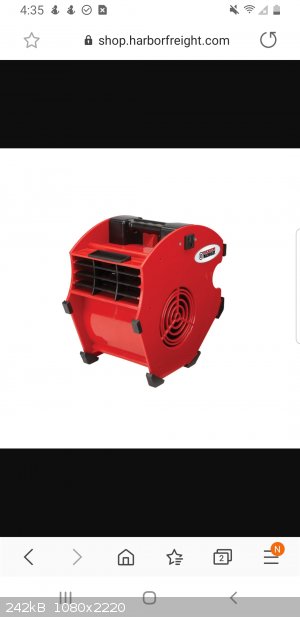Yttrium2
Perpetual Question Machine
    
Posts: 1104
Registered: 7-2-2015
Member Is Offline
|
|
Harbor freight Air Mover / Blower
So I used to have a harbor freight air blower that was used for growing mj. My dad had modified it by riviting on ducting pieces so it could fit that
silver air ducting stuff, looks like dryer vent ducting.
I can't remember if he also removed a piece to make it have more airflow, any ideas?
Perhaps people can use these in the construction of their fume hoods,
They are relatively inexpensive
Any ideas as to what parts are needed to connect one of these to ducting- and is it better to push or pull the air?
[Edited on 7/26/2020 by Yttrium2]

|
|
|
Fyndium
International Hazard
    
Posts: 1192
Registered: 12-7-2020
Location: Not in USA
Member Is Offline
|
|
I am a fan of these duct fans and carbon filters, see attachment.
I'm gonna use one for my upcoming fume hood to suction air out. It is rated to 800m3/h and I have a dimmer for it so I can reduce the flow. It can
create a very nice pressure gradient and it is very effective at eliminating any pot smell, so it should fork for chemistry as well.
|
|
|
wg48temp9
National Hazard
   
Posts: 784
Registered: 30-12-2018
Location: not so United Kingdom
Member Is Offline
|
|
Caution: Many induction motors can not have their speed changed significantly with a dimmer (phase controller) due to overheating of the windings.
I am wg48 but not on my usual pc hence the temp handle.
Thank goodness for Fleming and the fungi.
Old codger' lives matters, wear a mask and help save them.
Be aware of demagoguery, keep your frontal lobes fully engaged.
I don't know who invented mRNA vaccines but they should get a fancy medal and I hope they made a shed load of money from it.
|
|
|
Yttrium2
Perpetual Question Machine
    
Posts: 1104
Registered: 7-2-2015
Member Is Offline
|
|
there is a control switch on the fan
Fyndium, I did not see any attachment
|
|
|
Fyndium
International Hazard
    
Posts: 1192
Registered: 12-7-2020
Location: Not in USA
Member Is Offline
|
|
That's because I forgot to attach it. 
The dimmer works well in 40-100% power range, below that it gets too hummy.

|
|
|
Yttrium2
Perpetual Question Machine
    
Posts: 1104
Registered: 7-2-2015
Member Is Offline
|
|
Can anyone tell me anything about this harbor freight air mover /blower?
Is it an induction motor? ?
|
|
|
Fyndium
International Hazard
    
Posts: 1192
Registered: 12-7-2020
Location: Not in USA
Member Is Offline
|
|
According to this source,
https://www.acinfinity.com/blog/the-differences-between-inli...
Inline duct fans operate, according to that source, an EC motor or a brushless DC motor:
https://en.wikipedia.org/wiki/Brushless_DC_electric_motor
Brushless DC motors are also used when EX proofing is required. So inline duct fans should be a good choice for fume hoods, including the fact that
the fans are made of plastic that is likely quite resistant to most fumes.
Including also the fact that centrifugal fans produce orders of magnitude higher pressure difference with far lower power consumption and they are a
lot quieter, I see no reason to invest into one, since it costs only 100 euros or around.
|
|
|
Mateo_swe
National Hazard
   
Posts: 541
Registered: 24-8-2019
Location: Within EU
Member Is Offline
|
|
The fans used on boats in the engine compartments is explosion proof, they must be.
I dont know if they can be found in big enough sizes for a fumehood.
Generally ATEX classed (explosion proof) fans are very expensive.
Brushless motors dont have the spark producing contacts but im not 100% sure its enough to be explosion proof.
Maybe someone else know this better.
In theory they should not produce sparks, but i dont know if it would work in reality.
I would want to have all electronics isolated and mounted away from the possibly explosive airstream.
It would be interesting to know if brushless fans are usable for fumehoods if electronics except windings are mounted away from the airstream.
|
|
|
Fyndium
International Hazard
    
Posts: 1192
Registered: 12-7-2020
Location: Not in USA
Member Is Offline
|
|
Just as a thought, the fan could be excluded when handling extremely flammable stuff like flammable gases, ether, hydrogen or similar. For low
volatility stuff, especially the smelly ones it should work well. Like said earlier too, if the airflow is kept strong enough, the air displacement
keeps the concentration way too low to allow conditions for ignition, unless something like spillage of volatile liquid happens.
[Edited on 29-7-2020 by Fyndium]
|
|
|
Yttrium2
Perpetual Question Machine
    
Posts: 1104
Registered: 7-2-2015
Member Is Offline
|
|
So I got my harbor freight blower fan, right now it's blowing air into the room.
I'm wondering how I can attach ducting like my father did
He had a piece that was square that then went to a circular 6" diameter connection, it was some sort of flange that fit over the fan, and was riveted
on.
What's that piece called?
Also, if the fan is warm from use and then the power is disconnected, will the fan heat up because the cooling has been cut? My guess is no. Same with
vehicles, after the switch is shut off, do they get any hotter?
Any additional comments on the fan that *I* posted?
Can it be used for a fume hood fan and how can it be connected to ducting? I need to know the name of the ducting flange
[Edited on 8/4/2020 by Yttrium2]
 
|
|
|
Yttrium2
Perpetual Question Machine
    
Posts: 1104
Registered: 7-2-2015
Member Is Offline
|
|
I guess what I am after is called a router flange
This was cut in the corners, it was slipped over the portable blower, and riveted tight onto it, after holes were drilled.
I'm hoping I can set something up, though I may not be as crafty as my dad.
|
|
|
macckone
Dispenser of practical lab wisdom
    
Posts: 2168
Registered: 1-3-2013
Location: Over a mile high
Member Is Offline
Mood: Electrical
|
|
I would not work around hydrogen with a regular induction motor.
Ethanol, I would say is ok.
Explosion proof motors have a ton of requirements.
A non-sparking motor is not the same as explosion proof.
In an explosion proof motor everything has to be conductive and grounded.
They can't have sparks in a temperature cut off either.
There are heat limits and spark arrestors and if there is an explosion the motor has to contain it.
|
|
|
Yttrium2
Perpetual Question Machine
    
Posts: 1104
Registered: 7-2-2015
Member Is Offline
|
|
-
Why does fume hood construction have to be so complex? What is something uber simple I could use as my box, besides cardboard?
In a previous post, I saw a leaf blower was used as a fume hood fan, and the fume hood itself was simply pieces of wood with saran wrap wrapped around
the sides (to form a container of sorts)
-- I'd like something that looks good *is simple*, and is functional for most basic things, --What else can't be done in the fume hood constructed
with the fan that I am using?
my fan is rated at 300cfm, how big of a box can I make?
I was thinking of an acrylic or plexiglass (whatever display cases are made from) -- display case. But I would need one with some sort of a sash, I'm
not sure how I'm going to add a sash.
Also, about the sash, -- if it is shut, there isn't any airflow pulling the fumes out correct? -- Why would one want to shut the sash?
Can I use this pvc plastic to form the sides of my box?? ( I'd prefer the entire thing to be clear)
[Edited on 8/4/2020 by Yttrium2]

|
|
|
macckone
Dispenser of practical lab wisdom
    
Posts: 2168
Registered: 1-3-2013
Location: Over a mile high
Member Is Offline
Mood: Electrical
|
|
Recommended face velocity is 100fpm.
For a 300cfm fan, that means you can have 3 sq ft of sash opening at operating velocity of 100fpm.
You can go lower on face velocity depending on design, for a home made box I would say stick with a higher face velocity.
As for the sash, you want to have an alternative air entry (usually with splash guard, flame arrester, etc - serpentine path), that way if the sash is
closed there is still air flow.
In a good commercial hood, the alternative air entry is pressure activated. The reason to close the sash completely is if there is a risk of
explosion or fire. The serpentine alternative air entry will allow minimal air flow and usually there is a inert gas flooding mechanism that can be
activated.
As for material, you can use cardboard.
You could use saran wrap or anything else if it is just to confine fumes.
Keeping in mind you may want to apply a coating to reduce flammability.
Lab fires can be VERY VERY BAD, you probably want something to stop a fire, keeping in mind you may be using things that a standard ABC extinguisher
will not put out.
PVC is a good material for a box as it is lower flammability and resistant to acids, but it will react with acetone and MEK.
Fumes from acetone and MEK will cause the PVC to cloud up.
You can have similar problems with other materials (acrylic, polycarbonate).
Glass is nice because it doesn't cloud with anything other than HF.
The down side of glass is the case of explosion.
Commercial lab hoods have safety glass that has two outer layers of glass and an inner layer of polycarbonate.
|
|
|
Yttrium2
Perpetual Question Machine
    
Posts: 1104
Registered: 7-2-2015
Member Is Offline
|
|
Reducing it down to one question, macckone, what do you mean I can have a 3 sq ft sash opening?
The sash is the sliding piece of glass to cover the fume hood, right?
How big of a box is 3 sq ft? (I really should know this by now, in surprised I don't, if there is one thing I should learn today it is this)
Isn't that only around 1.7ft x 1.7ft? - what about how tall?
Doesn't volume of the box come into play?
You said I could use saran wrap if it is just to confine the fumes, -- isn't that what the fume hoods are for?
I am also not sure now or where I'm going to mount my fan, I was thinking inside of the hood, but I think this will look ugly, I might need some sort
of other flange for the intake vent of the fan that I have. Not sure how I'm going to rig that up.
Wondering if there is a premade box I could use for distillations (400mm) liebig, and reflux, if needed -- (400mm)
[Edited on 8/4/2020 by Yttrium2]
|
|
|
Yttrium2
Perpetual Question Machine
    
Posts: 1104
Registered: 7-2-2015
Member Is Offline
|
|
I greatly look forward to a response on these, some of these questions
|
|
|
Yttrium2
Perpetual Question Machine
    
Posts: 1104
Registered: 7-2-2015
Member Is Offline
|
|
Does anyone know if my blower needs to have the squirrel cage part drilled out a bit like the lasko fans here https://forum.grasscity.com/threads/basic-diy-modifying-a-st...
I'm really wondering how much of a bugger it is going to be to attach to ducting, I dont know if I need to modify the insides or what, -- Why were the
insides modified in that lasko fan (in the link above?)
|
|
|
Syn the Sizer
National Hazard
   
Posts: 600
Registered: 12-11-2019
Location: Canada
Member Is Offline
|
|
What he means is while using the fume hood you don't want an opening larger than 3sq feet to maintain your minimum 100fpm. Or that us how I
understand, with 500cfm fan you could have 5 sq feet. If the opening is too big for the power of the fan you will not pull enough fumes out. I believe
the fume hood volume does play a roll but not ad much as the sash opening to fan speed.
3 sq feet is 1'x3', 2'x1.5' or as you said approximately 1.7'x1.7', or really any equivalent, I mean 1"x36' is 3 sq feet. But I think 3 feet wide by
one foot high to 2 feet wide by 1.5 feet high is a good size. The max operating height of out sashes at school is 12", easy for a average person to
work in and low enough just incase something flies everywhere. Though all 8 fume hoods have one huge exhaust fan so if we have a taller student they
can close one of the unused hoods and raise their sash slightly.
I do have a related question though, as Yttrium2 said you need the sash open for airflow, is there a maximum airflow, like lets say I had a 300cfm
fan, but I lowered the sash by 4" temporarily, turning my 3 sq foot opening into a 2 sq foot opening, is there going to be too much air draw or is
that not as much of a concern?
Edit:
I understand that if the draft is too strong a you are using an alcohol lamp it could bend or snuff the flame, I don't see it being as big a deal with
a bunsen burner since it uses a pressurized fuel source.
[Edited on 5-8-2020 by Syn the Sizer]
|
|
|
Syn the Sizer
National Hazard
   
Posts: 600
Registered: 12-11-2019
Location: Canada
Member Is Offline
|
|
Honestly man, unless somebody has that exact fan you are probably going to not get all the answers you need. Do you own the fan yet? If you do look at
it.
As well google (or whatever search engine you use) is your friend, simply type in your question exactly like you ask in the forum and googles big
brained bots will find many answers.
|
|
|
Yttrium2
Perpetual Question Machine
    
Posts: 1104
Registered: 7-2-2015
Member Is Offline
|
|
Quote: Originally posted by Syn the Sizer  |
Honestly man, unless somebody has that exact fan you are probably going to not get all the answers you need. Do you own the fan yet? If you do look at
it.
As well google (or whatever search engine you use) is your friend, simply type in your question exactly like you ask in the forum and googles big
brained bots will find many answers. |

|
|
|
macckone
Dispenser of practical lab wisdom
    
Posts: 2168
Registered: 1-3-2013
Location: Over a mile high
Member Is Offline
Mood: Electrical
|
|
The volume of the hood isn't relevant to the face velocity.
The square footage that matters is the size of the sash opening.
1' x 3' is a good opening for a 300 cfm fan.
2' x 1.5' or 1.7' x 1.7' will work but you have to have even airflow.
As for the material, you probably want something that will withstand small lab fires and other mishaps. Saran wrap would work, but it isn't a good
idea. You want something at least modestly flame resistant. Saran wrap is very flammable. It also has to withstand the suction of the fan.
The limit on the maximum face velocity is 'doesn't cause problems running experiments'.
Things don't work well in a wind tunnel. The fan suction can cause a poorly constructed hood to implode if it is high enough. Most fans that are
going to be reasonably cheap aren't going to cause sufficient suction for plywood or even cardboard to collapse but might with saran wrap.
|
|
|
CouchHatter
Hazard to Others
  
Posts: 152
Registered: 28-10-2017
Location: Oklahoma
Member Is Offline
Mood: 76 elements taken!
|
|
FRP is cheap and semi-resistant to most stuff. Fairly rigid. That's what I'd use if I didn't use metal.
I have an identical blower Yttrium2, I will look at it tomorrow. It probably has two intakes, so you would want to follow the grasscity guide. The
grasscity guide seems to convert the double-intake blower into a single intake and connect the now single intake to some duct.
Fans can rise in temp after you turn them off. Some fans (like the Lasko) are designed to pull air past the motor while running, effectively cooling
it during operation. And by not pulling air past the motor, your motor might suffer. But it might be just fine, hard to say.
|
|
|